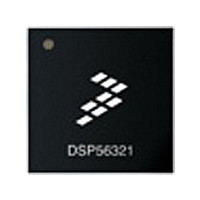DSP56303VL100 Freescale Semiconductor, DSP56303VL100 Datasheet - Page 28

DSP56303VL100
Manufacturer Part Number
DSP56303VL100
Description
IC DSP 24BIT 100MHZ 196-MAPBGA
Manufacturer
Freescale Semiconductor
Series
DSP563xxr
Type
Fixed Pointr
Datasheet
1.DSP56303AG100.pdf
(108 pages)
Specifications of DSP56303VL100
Interface
Host Interface, SSI, SCI
Clock Rate
100MHz
Non-volatile Memory
ROM (576 B)
On-chip Ram
24kB
Voltage - I/o
3.30V
Voltage - Core
3.30V
Operating Temperature
-40°C ~ 100°C
Mounting Type
Surface Mount
Package / Case
196-MAPBGA
Device Core Size
24b
Format
Fixed Point
Clock Freq (max)
100MHz
Mips
100
Device Input Clock Speed
100MHz
Ram Size
24KB
Program Memory Size
Not RequiredKB
Operating Supply Voltage (typ)
3.3V
Operating Supply Voltage (min)
3V
Operating Supply Voltage (max)
3.6V
Operating Temp Range
-40C to 100C
Operating Temperature Classification
Industrial
Mounting
Surface Mount
Pin Count
196
Package Type
MA-BGA
Package
196MA-BGA
Maximum Speed
100 MHz
Device Million Instructions Per Second
100 MIPS
Lead Free Status / RoHS Status
Lead free / RoHS Compliant
Available stocks
Company
Part Number
Manufacturer
Quantity
Price
Company:
Part Number:
DSP56303VL100
Manufacturer:
FUJI
Quantity:
1 000
Company:
Part Number:
DSP56303VL100
Manufacturer:
FREESCALE
Quantity:
672
Company:
Part Number:
DSP56303VL100
Manufacturer:
Freescale Semiconductor
Quantity:
10 000
Company:
Part Number:
DSP56303VL100B1
Manufacturer:
Freescale Semiconductor
Quantity:
10 000
Specifications
2-8
Notes:
No.
1.
2.
3.
4.
5.
6.
7.
8.
When fast interrupts are used and IRQA, IRQB, IRQC, and IRQD are defined as level-sensitive, timings 19 through 21 apply to
prevent multiple interrupt service. To avoid these timing restrictions, the deasserted Edge-triggered mode is recommended
when fast interrupts are used. Long interrupts are recommended for Level-sensitive mode.
This timing depends on several settings:
• For PLL disable, using internal oscillator (PLL Control Register (PCTL) Bit 16 = 0) and oscillator disabled during Stop (PCTL
Bit 17 = 0), a stabilization delay is required to assure that the oscillator is stable before programs are executed. Resetting the
Stop delay (Operating Mode Register Bit 6 = 0) provides the proper delay. While Operating Mode Register Bit 6 = 1 can be set,
it is not recommended, and these specifications do not guarantee timings for that case.
• For PLL disable, using internal oscillator (PCTL Bit 16 = 0) and oscillator enabled during Stop (PCTL Bit 17=1), no
stabilization delay is required and recovery is minimal (Operating Mode Register Bit 6 setting is ignored).
• For PLL disable, using external clock (PCTL Bit 16 = 1), no stabilization delay is required and recovery time is defined by the
PCTL Bit 17 and Operating Mode Register Bit 6 settings.
• For PLL enable, if PCTL Bit 17 is 0, the PLL is shutdown during Stop. Recovering from Stop requires the PLL to get locked.
The PLL lock procedure duration, PLL Lock Cycles (PLC), may be in the range of 0 to 1000 cycles. This procedure occurs in
parallel with the stop delay counter, and stop recovery ends when the last of these two events occurs. The stop delay counter
completes count or PLL lock procedure completion.
• PLC value for PLL disable is 0.
• The maximum value for ET
MHz = 62 µs). During the stabilization period, T
well.
Periodically sampled and not 100 percent tested.
Value depends on clock source:
• For an external clock generator, RESET duration is measured while RESET is asserted, V
active and valid.
• For an internal oscillator, RESET duration is measured while RESET is asserted and V
reflects the crystal oscillator stabilization time after power-up. This number is affected both by the specifications of the crystal
and other components connected to the oscillator and reflects worst case conditions.
• When the V
device circuitry is in an uninitialized state that can result in significant power consumption and heat-up. Designs should
minimize this state to the shortest possible duration.
If PLL does not lose lock.
V
WS = number of wait states (measured in clock cycles, number of T
Use the expression to compute a maximum value.
CC
= 3.3 V ± 0.3 V; T
Table 2-7.
A[0–17]
RESET
All Pins
CC
is valid, but the other “required RESET duration” conditions (as specified above) have not been yet met, the
Characteristics
J
= –40°C to +100°C, C
Reset, Stop, Mode Select, and Interrupt Timing
C
8
is 4096 (maximum MF) divided by the desired internal frequency (that is, for 66 MHz it is 4096/66
DSP56303 Technical Data, Rev. 11
Figure 2-3.
L
C
= 50 pF.
, T
H,
and T
Reset Value
Reset Timing
9
L
is not constant, and their width may vary, so timing may vary as
C
).
Expression
6
(Continued)
CC
CC
is valid. The specified timing
10
is valid, and the EXTAL input is
First Fetch
Freescale Semiconductor
Min
100 MHz
V
IH
Max
Unit












